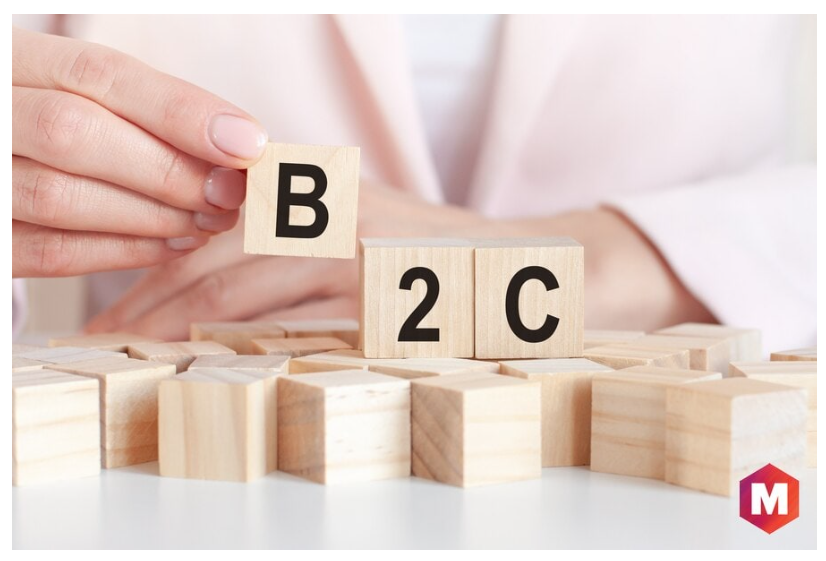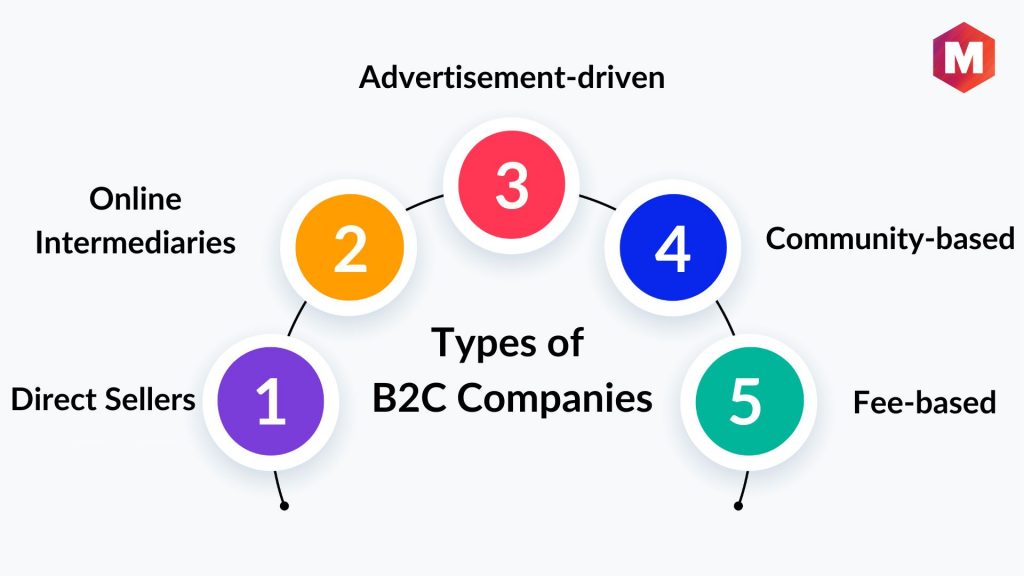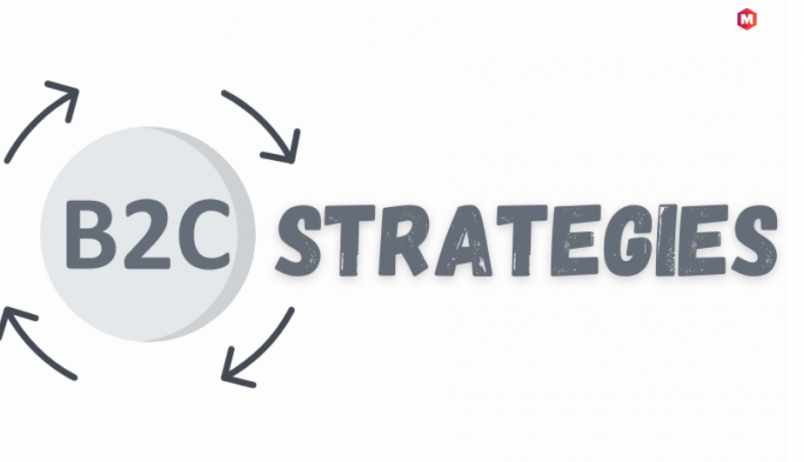Directly selling goods and services to consumers is called business-to-consumer (B2C). Retailers often target specific clients or end-users with this strategy. B2C has extended into online purchasing and e-services, making it crucial to the current economy.
B2C models influence consumer trends, preferences, and purchases. Create a direct link between your business and those who need your products or services daily.
During the late 1990s dot-com boom, online firms sold items and services to consumers worldwide, making B2C popular. Overall, business-to-consumer marketing involves selling directly to consumers.
Table of Contents
What is Business-to-Consumer?
Business-to-consumer B2C business models involve enterprises selling items or services directly to end users or consumers, eliminating the need for a middleman. B2C marketing refers to marketing efforts or online advertisements to promote firms to their target customers.
B2C also includes selling advertising space, which has recently gained popularity. Online merchants like Amazon and eBay are well-known examples of business-to-consumer. They both offer websites where clients may select things to purchase directly from the company, with no third parties or sales processes involved.
This sort of marketing enables organizations to establish a direct line of communication with their target customers and utilize personalization, loyalty programs, discounts, and other incentives to persuade them to buy products or services.
Key Takeaways!
- Business-to-consumer models use customer data to personalize purchasing experiences and increase customer loyalty.
- Using the internet and social media platforms in B2C models improves direct engagement with customers and facilitates focused marketing initiatives.
- While third-party internet merchants provide a significant platform for product exposure, business-to-consumer models frequently deliver a more direct and customized client experience.
- eCommerce websites are critical components of B2C models because they provide a virtual storefront that is available to clients 24/7.
Understanding B2C Business Model
Business-to-consumer (B2C) marketing is one of the most widely used and recognized sales tactics. In 1979, Michael Aldrich, who employed television as the primary medium for customer outreach, established the notion of B2C.
Business-to-consumer (B2C) marketing is one of the most widely used and recognized sales tactics. In 1979, Michael Aldrich, who employed television as the primary medium for customer outreach, established the notion of B2C.
Business-to-consumer marketing is developing a distinct brand voice that appeals directly to customers and convinces them to buy items or services from the company. To make a long-term impression on their target consumers, firms must generate relevant, entertaining, and useful content.
It is one of the several business models in existence, which include:
1. B2B (Business-to-Business)
This model refers to transactions between two businesses, such as a manufacturer selling to a wholesaler or a wholesaler selling to a retailer.
2. B2G (Business-to-Government)
This approach involves firms supplying goods, services, or information to local, state, or federal governments.
3. C2C (Consumer-to-Consumer)
This model promotes private-sector commerce. These transactions are frequently handled through a third company that offers an internet platform, such as eBay.
4. G2B (Government-to-Business)
This model refers to transactions and interactions between the government and the commercial business sector, generally rules or services.
5. G2C (Government-to-Citizen)
In this model, the government offers services to its citizens directly, usually through a dedicated website or portal.
Business-to-consumer marketing is also popular for small firms looking to compete and participate in the digital age. Companies can reach clients online, including websites, social media, emails, and search engine optimization (SEO).
Evolution of B2C eCommerce
As the internet grew with the dot-com boom, B2C business models became popular in the 1990s. E-commerce’s future was indicated in publications like The Future Shop: How Technologies Will Change the Way We Shop and What We Buy (1992).
However, security issues were slowing corporate expansion. Internet users felt safer sending data online once Netscape introduced SSL encryption certificates.
This allowed web browsers to detect authorized SSL certificates, a key component of current web security. Thus, users could decide if a site was trustworthy.
E-commerce grew in the mid-1990s and 2000s thanks to Zappos, Amazon, and others after SSL. This led to a world where most businesses offer their products through online retailers. Consumers like internet shopping from home, while firms may flourish on cheap overhead.
B2C e-commerce’s virtual storefront lets a business operate smoothly without a storefront or a huge inventory, benefiting many small enterprises. Fulfillment centers and dropshipping firms have grown, allowing merchants to act as intermediaries between a third-party warehouser and target users, boosting B2C sales models.
How does business-to-consumer (B2C) work?
Businesses that offer goods and services directly to consumers are known as B2C. A consumer is a person who buys a product or service for their own consumption. Although many businesses sell their items, the B2C model does not necessitate this because many firms also offer things bought from other businesses.
Shopping at a local grocery store or ordering new headphones from an internet retailer are examples of B2C retail experiences. A B2C service experience may include going to the doctor, a hair or nail salon, dining out, or utilizing the Uber app.
Types of B2C Companies
There are five business models in online business-to-consumer sales.
Direct Sellers
This model, which is the most common, basically turns the internet into a market where people can buy things straight from online stores. In this group are a lot of different kinds of stores, from big global brands to small local businesses that run on their own or online versions of physical department stores that sell a wide range of goods from different brands.
Online Intermediaries
These entities are facilitators, creating a platform that brings buyers and sellers together without owning the products or services. For example, Etsy is an e-commerce website that connects artists and crafters with buyers, and travel sites like Expedia and Trivago allow people to compare and book different types of travel services.
Advertising-based Models
With this plan, free content is used as an appealing lure to get people to visit a website, where they will see digital or online ads in between the content. More web traffic means more ads can be seen, which means it is more likely that goods and services will be sold. Major news sites, like HuffPost, do a good job of using this model to combine ads with their popular content.
Community-based Models
The power of shared interests binds online communities, which such models leverage. They are used frequently by networks like Meta (formerly Facebook), where advertisers directly promote goods to users based on their demographics and nearby locations.
Fee-based Models
In this case, websites charge people directly to view their content. This is how websites like Netflix work. People may be able to get some information for free, but they may have to pay to get the bigger chunk. This is often how traditional media, such as The New York Times, work online.
Each of the above models has its unique digital strategy meant to attract and keep the customers they want while also providing value and making it easy for customers to interact with the brand in the digital market, which is becoming increasingly competitive.
Benefits of business-to-consumer (B2C)
E-commerce is a big part of modern B2C. Many B2C businesses may need a physical location, reducing overhead while expanding the target audience. Because they are online, B2C organizations may collect vast volumes of data linked to their operations and utilize analytics to improve company policies and plans.
1. Business-to-consumer (B2C) vs. business-to-business (B2B)
The target market is the significant difference between the B2C and B2B retail models. B2C businesses often sell products directly to customers, whereas B2B firms sell to other companies and then service other businesses or customers.
Business-to-business is abbreviated as B2B. B2B enterprises specialize in selling goods and services to other companies. B2C caters to consumers, delivering products or services that make sense to purchase individually.
2. Internet Retailers vs. B2C Storefronts
Traditionally, most producers marketed their products to brick-and-mortar stores. Retailers profited from the markup they added to the manufacturer’s pricing. That changed, though, when the Internet arrived.
New enterprises were formed with the promise of selling products directly to the consumer, bypassing the store, and decreasing prices. Businesses tried to maintain an online presence during the dot-com crash in the 1990s. Due to the crisis, many stores were forced to close their doors and go out of business.
Business-to-Consumer Companies
Walmart and Target are some popular and traditional B2C examples. Amazon is one of the most common examples of a popular e-commerce B2C business model.
Some of the other highly popular B2C companies are-
1) Google
As a premier B2C company based in the US, Google provides various services, from search engine capabilities to cloud storage, driving user engagement through innovation and simplicity.
2) Tencent
Tencent has revolutionized the B2C landscape in China, offering everything from social networking services to online multiplayer games, making digital life seamless for its consumers.
3) Facebook
With its social media platform, Facebook connects billions of people globally, enabling them to share content and experiences, thus embodying the essence of the B2C model.
4) Target
Utilizing both online and physical outlets, Target offers various products, catering to consumers’ diverse needs and maintaining a strong B2C presence.
5) Walmart
Walmart stands as a testament to the power of B2C. It seamlessly integrates in-store shopping with an online platform, making everyday necessities accessible to consumers.
6) Alibaba
Alibaba’s online marketplace has redefined B2C, allowing consumers to purchase a vast range of goods from international vendors, making shopping truly borderless.
7) Netflix
Netflix revolutionized the entertainment sector by providing on-demand streaming services to consumers, leading the B2C movement in the media industry.
8) Priceline Group
Priceline Group’s travel booking platforms allow consumers to easily access flights, hotels, and more, making it a leading B2C company in the travel industry.
9) eBay
eBay, an online auction and shopping website, empowers consumers to buy a diverse set of goods, exemplifying the convenience and versatility of the B2C model.
B2C Companies and Mobile
In the past few years, B2C companies have put much effort into adapting to a growing market: mobile shopping. Businesses are taking advantage of the huge potential that this dynamic platform offers because they are inspired by the steady rise in smartphone use and the power of mobile apps.
Around the turn of the century, B2C businesses rushed ahead of the e-commerce wave. There has been a similar rush to improve mobile app development in the last ten years. One thing driving this trend is the idea that the best way to do well in B2C is to keep up with changing customer behavior patterns, tastes, trends, and market preferences.
Here are some important things to remember from the situation:
- The popularity of mobile shopping has greatly changed the ways that business-to-consumer (B2C) businesses do things, making them pay more attention to mobile users.
- Many businesses have been rushing to improve mobile app development in the last ten years, just like there was a rush in e-commerce in the early 2000s.
- Businesses that sell to customers (B2C) must constantly change and quickly adapt to new tastes, trends, and needs to stay competitive and successful.
How can B2C e-commerce benefit you over a traditional store?
In reality, B2C eCommerce has many benefits for small businesses compared to traditional shops. The main benefits are reaching more people, lower costs, and better customer knowledge.
- Global Customer Access: You’re not bound to a geographical location through eCommerce. Your customers can shop at your online store from anywhere in the world as long as they have access to the internet, including people who live in your city. Because of this benefit, businesses can expand their target audience to include anyone with an internet connection who wants to buy their goods.
- Diminished Overhead Costs: Traditional storefronts incur several overhead costs, including rent, salaries, utilities, taxes, maintenance, and insurance fees. These problems are gone with eCommerce because the business does not need a real location to run. So, switching to eCommerce can cut your general costs by a huge amount.
- Enriched Customer Profiling: In a conventional store, customers are often limited to familiar faces. However, eCommerce lets companies use online analytical tools to create thorough profiles of their customers. This data collection includes feedback, demographic information, shopping history, and product preferences, allowing each customer a unique, custom-buying experience.
How B2C is different from B2B, C2C & B2G
1. B2B (Business-to-Business)
In this model, a business or manufacturer first sells its product or service at wholesale prices to a retailer, then sells that product or service to the end-user or consumer at retail prices. Examples of this model can be Cisco Systems or Denso Corp., which are auto parts manufacturers.
2. C2C (Consumer-to-Consumer)
This business model lets individuals find and transact with each other, such as Etsy or eBay.
3. B2G (Business-To-Government) Business Model & Examples
This business model is associated with companies that offer products or services to government institutions or agencies. One key example of such companies is Northrop Grumman, which incorporates 90,000 employees to focus on defense, aeronautics, and cyberspace.
B2C Marketing Strategies
With the booming prevalence of online businesses, B2C businesses face huge competition in the market. They need effective marketing strategies to optimize their online and offline marketplace presence.
For this, different strategies, such as Search engine optimization, customer loyalty programs, marketing automation, social media marketing, content marketing, reward programs, influencer marketing, retargeting, feedback, and testimonials, are used to attract consumers or potential customers and convert them into buyers and loyal customers.
Understanding the needs of individual customers and ensuring a personalized customer experience has become extremely important for B2C businesses to connect with and convince consumers to buy products or services.
Conclusion!
Many brick-and-mortar businesses build their online presence alongside their physical storefront to stay competitive. Different types of companies need a new and unique tactic to promote them and optimize their market presence so the end consumer sees and purchases their products or services. B2C marketing empowers businesses to take their brands to the next level, develop good relations with individual consumers, and optimize sales and conversions.
Frequently Asked Questions on B2C E-commerce
1. Could you provide an example of a B2C operation?
Think about a shop that is only open online. People can look at, choose, and buy books straight from its website. From looking to buying, the whole sales process happens inside the company, without any help from a third party. This business plan is mostly B2C (Business to Consumer).
2. What is the contrast between B2C and B2B models?
The business words “B2C” and “B2B” refer to two different types of transactions.
A business’s product or service ends with a customer in a B2C model. One example of a B2C deal is when you buy a mystery book from an online bookstore.
On the other hand, a business-to-business (B2B) model occurs when one business sells goods or services to another company. These can come from professional services, technology apps, or raw materials. For example, a printing company selling paper to the online shop we just discussed is a classic case of a B2B deal.
It is important to remember that these types are not completely different from each other. Different types of businesses use both, depending on their type and the customers they serve.
3. Why is B2C a popular business model?
B2C, which stands for “Business-to-Consumer,” has become very popular for several main reasons:
- Fast Sales Cycle: Business-to-consumer (B2C) companies usually have a short sales cycle because they deal directly with customers.
- Broad Customer Base: Business-to-consumer (B2C) marketing can directly reach many different types of customers, which means there are more chances to make sales.
- Competitive Prices: Because business-to-consumer (B2C) transactions are more efficient, companies can sell goods and services for less money.
- Less money spent on running the business: Since B2C does not usually need a physical storefront, overhead and maintenance costs are generally lower.
4. What are some strategies for B2C success?
If you want to be successful in B2C, here are some important things you should do:
- Focus on the customer: Understand how they act and what they need to provide better value.
- Digital Marketing Influence: Use SEO, social media, and email marketing strategies to reach your target group.
- Data-Informed Decisions: Use analytics to change your strategy and processes based on data.
- Prioritize User Experience: To keep customers happy and loyal, ensure their online shopping experience is easy and smooth.
5. What are the advantages of B2C?
Businesses can get a lot out of business-to-consumer (B2C), especially regarding e-commerce.
- Lowered Costs: Because there is not usually a need for a real storefront, operational and overhead costs are often lower.
- Reach More People: Because B2C is online, it can serve customers from all over the world.
- Data-Driven Insights: Business-to-consumer (B2C) marketing allows companies to obtain useful information about customers’ behavior and preferences, which can help them improve their business plans.
6. B2C is a crucial part of our economy
B2C is an important part of the global market and helps many people. Since B2C iss growing along with e-commerce, it is becoming more critical and useful. Statista, for example, said that US retail e-commerce sales reached almost $266 billion in the third quarter of 2022. As a result, this business plan will continue to grow and have an impact.
Businesses should know what their customers want and work hard to make their products stand out from the rest if they want to be successful in the B2C market.
Liked this post? Check out the complete series on Marketing


